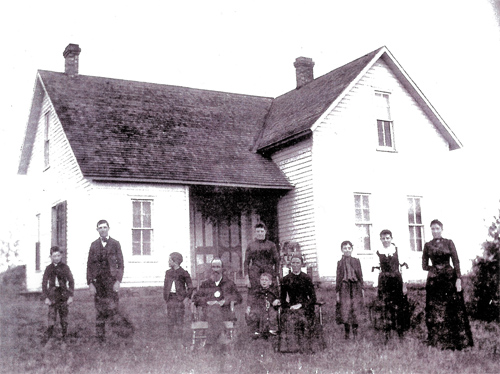 Courtesy photo “Midnight Assassin” by Patricia L. Bryan and Thomas Wolf
Courtesy photo “Midnight Assassin” by Patricia L. Bryan and Thomas WolfThe John Hossack family in 1892, Medora, Iowa, Warren County. From L to R: Will, Johnnie, Jimmie, John Hossack, Cassie, Ivan, Margaret Hossack, May, Louie and Anna.
John Hossack
Homicide
John Hossack
59 YOA
Squaw Township
Medora, IA
Warren County
December 2, 1900
Right around midnight on a moonlit night between Saturday, Dec. 1, 1900 and Sunday, Dec. 2, prosperous Warren County, Iowa farmer John Hossack was murdered in his bed by two blows of an ax to his head. Four days later, Hossack’s wife of 32 years, Margaret (Murchison) Hossack, was arrested at her husband’s funeral and charged with killing him in the couple’s home sometime around 12 a.m. while he slept.
The vicious assault stunned and divided the close-knit rural community. Margaret Hossack claimed to be innocent, but stories of domestic troubles and abuse provided prosecutors with a motive for the crime.
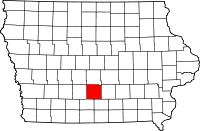
Warren County in Iowa
Neighbors and family members were reluctant to talk about what they knew concerning the couple’s troubled marriage.
The “Lizzie Borden of Iowa”
Margaret Hossack claimed she’d been sleeping next to her husband at the time of the murder but that she had not heard a thing.
Despite her claims of innocence, the murder case against her moved forward in what became one of the most sensational murder trials in Iowa history.
Shep, the Hossacks’ 10-year-old dog, figured prominently in the trial, especially in the argument for the defense. During the first trial, one newspaper headline proclaimed, “DEFENSE HOPES REST UPON HOSSACK DOG.”
 Courtesy photo “Midnight Assassin” and Amazon.com
Courtesy photo “Midnight Assassin” and Amazon.comA plat of the Hossack home, included in the book by Bryan and Wolf.
Shep was reputed to be an active dog with a tendency to bark at stray cattle and strangers.
On the night of the murder, Margaret Hossack testified that she had heard Shep barking vigorously between 9 and 10 p.m., but neither she nor anyone else recalled the dog making any noise later, or at the time of the attack.
Several family members and neighbors who saw the dog after the murder thought he was quiet and uncharacteristically listless, fueling speculation that the assailant had drugged the dog with chloroform. When the defense made that argument in court, the prosecution countered by claiming that Shep had witnessed Margaret Hossack killing her husband and that the dog’s demeanor expressed shame and sorrow.
On April 11, 1901, after five days of testimony before an all-male jury, Margaret Hossack was found guilty of her husband’s murder and sentenced to life in prison. Her conviction was overturned one year later and she was released on bail to await a retrial. The second trial in adjacent Madison County ended with a hung jury verdict; nine jurors voted to find her guilty, while three held out and voted “not guilty.”
Authors Patricia Bryan and Thomas Wolf researched the Hossack case for nearly a decade before writing Midnight Assassin.
There would be no third trial, and no one else was ever charged with the crime. Margaret Hossack refused to discuss the murder after the second trial.
In what some considered an added insult to injury, Margaret Hossack — dubbed the “Lizzie Borden of Iowa” — was buried in the family plot next to the husband she allegedly murdered.
Midnight Assassin
Patricia L. Bryan and Thomas Wolf researched the Hossack case for almost a decade — combing through legal records, newspaper accounts, government documents and unpublished memoirs — before depicting the murder and trials in their book, Midnight Assassin: A Murder in America’s Heartland (Bur Oak Book) , published by the University of Iowa Press in August 2007.
, published by the University of Iowa Press in August 2007.
The Midnight Assassin website has this to say about the book:
MIDNIGHT ASSASSIN takes us back to the murder, the investigation, and the trials of Margaret Hossack. The book introduces us to Susan Glaspell, a young journalist who reported the story for the Des Moines Daily News and fifteen years later transformed the events into the classic one-act play, “Trifles”, and the acclaimed short story, “A Jury of Her Peers.”
The book is described as a “vivid portrait of life in rural America at the turn-of-the century and a chilling step-by-step account of the crime and its aftermath.”
The comprehensive website includes a page listing the Hossack family members, neighbors, lawyers, judges, witnesses and observers as well as a Reading Guide, a page dedicated to Susan Glaspell, an excerpt from the book, and much more.
Co-author Wolf describes the book as a nonfiction narrative, and says in an author interview included on the book’s website:
To me, the story was both a whodunit–with an array of interesting social and legal angles–and a kind of micro history of the farm life in the Midwest a century ago. It was a compelling true drama: an unsolved murder that forced a whole community to deal with issues ranging from domestic abuse to the social roles played by men and women.
About John Hossack
John Hossack was born on May 26, 1841, in Ross Shire, Scotland. His family emigrated to Canada in 1842. Later, he made his way to Illinois, and in the spring of 1866 he found work on the farm of Alexander Murchison, in Stark County, Illinois. At this time, Hossack, who was one of several hired hands living on the Murchison farm, met his future wife, Margaret — the youngest child of his employer — as well as Margaret’s siblings: Alex, a Civil War hero who had returned home after serving in the war; Donald, a farmer; and Jane, who still lived with her parents.
John Hossack worked on the Murchison farm through the spring of 1866, left the farm for a short period, but returned a year later.
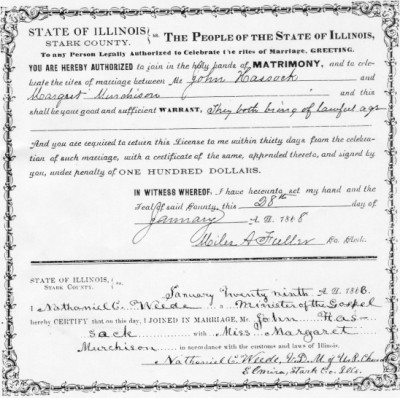 Courtesy photo “Midnight Assassin” by Patricia L. Bryan and Thomas Wolf
Courtesy photo “Midnight Assassin” by Patricia L. Bryan and Thomas WolfThe marriage certificate for Margaret Murchison and John Hossack, dated January 28, 1868.
In the fall of 1867, Hossack traveled to Iowa to look for land, and he purchased 120 acres in Warren County, paying $480 in cash. He returned to the Murchison farm in November or December. It was later reported that he had been interested in Jane Murchison, but “circumstances prevailed” and he married Margaret instead. Their wedding was held on January 29, 1868, in the living room of Donald Murchison’s house.
A few months later, John and Margaret Hossack moved to the land John had purchased in Warren County, Iowa, and they settled in a small house on the farm. John Hossack’s elderly parents joined them and lived there until they both died a few years later.
John Hossack established himself as one of the county’s most successful and prosperous farmers. To his family, Hossack could be moody and argumentative — he often clashed with his wife and children over how the household was run and what the children were allowed to do — but he was well-respected by his fellow farmers. He took a leadership role in his church, ran for political office, and served as a trustee of the county.
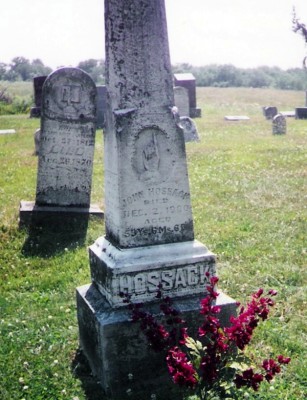 Courtesy photo Becky Pennington, findagrave.com
Courtesy photo Becky Pennington, findagrave.comJohn Hossack and his wife, Margaret, are buried in the New Virginia Cemetery in New Virginia, Warren County.
On Thanksgiving Day 1900, the Hossacks hosted a party at their farm for more than twenty people.
John Hossack was murdered two days later, attacked in the middle of the night while he slept in his bed. His violent death shocked the county.
The couple raised nine of 10 children, including sons Alexander (Alex) Hossack, Donald Hossack (died in infancy), John C. (Johnnie) Hossack, William D. (Will) Hossack, James (Jimmie) Hossack, and Ivan Hossack, and daughters Anna Jane (Annie) Hossack Henry, Margaret Lucretia (Louie) Hossack Kemp, Catherine (Cassie) Hossack, and Martha May Hossack Coulter. Son Ivan, the Hossack’s last child, was born when Margaret was almost 40 years old.
John Hossack was buried in the New Virginia Cemetery in New Virginia, Iowa, Warren County.
Margaret died August 25, 1916, at age 72, and was buried next to him. At the time of her death, Margaret had more than 20 grandchildren.
Sources:

 Courtesy photo “Midnight Assassin” by Patricia L. Bryan and Thomas Wolf
Courtesy photo “Midnight Assassin” by Patricia L. Bryan and Thomas Wolf
 Courtesy photo “Midnight Assassin” and Amazon.com
Courtesy photo “Midnight Assassin” and Amazon.com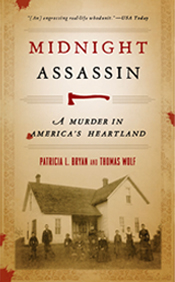
 Courtesy photo “Midnight Assassin” by Patricia L. Bryan and Thomas Wolf
Courtesy photo “Midnight Assassin” by Patricia L. Bryan and Thomas Wolf Courtesy photo Becky Pennington, findagrave.com
Courtesy photo Becky Pennington, findagrave.com
(Margaret had 9 kids)How did Margaret have her last kid when she was 40, even tho she killed her husband when she was 32 …….. suspicious. AND she has 20 GRANDCHILDREN THAT’S CRAZY ?!?!?!?!?
The article says she was his wife “of 32 years,” meaning they were married for 32 years at the time he was killed–from 1868 to 1900. She wasn’t 32 at the time of his death.
[…] authorities because they “understand” why she did it. This story is based on true events of the 1901 Hossack Murder Case which Glaspell covered as a reporter. A farmer’s wife (Margaret Hossack) was accused of killing […]
John Hossack an L for this
Who wrote this article
This wouldn’t have happened to me. I’m built different.
Good for you
facts
me personally wouldnt have let that slide
I did it. Cold blooded.
He got 360 noscoped. Cheeks clapped kid
gg
I honestly read Trifles before i read the article. It was more gruesome than i had anticipated in regards to how Hossack and his analog were murdered. Both are awful ways to die but the way trifles was written had an air of suspense to it.
I have also read the story trifles and it claims that a rope was used not an axe.
I agree that it was definitely the ax that killed him. What a horrible way to die considering the circumstances. In your opinion, did he really deserved to die? Could this situation be handed differently? Just a few thoughts that crossed my mind as I was reading the story.
Im interested as a Hossack from Cromarty Rosshire
does anyone know where Margaret was born?
Steve, the book Midnight Assassin states that Margaret (Murchison) Hossack was a native of Ross Shire, Scotland, born Nov. 19, 1843, and that at the age of five, she traveled with her family to North America. Not sure if that helps, but thought I’d put it out there.
I think the dog killed them
How can a dog use an ax?
Wow
Is the house still there?
O.J. did it,
I agree.
I second that
O.J. wanted to prove to people that he indeed was was a simp (last name Simpson) so he clapped the husbands cheeks cuz the husband abused her.
i think it was the axe that killed him.
Good book about that.
well…if the wife did do it….she was held accountable for her actions by the good lord above.
Don’t really agree with that one.
Doesn’t matter if you agree with that or not, Bob Platt. The Holy Bible says, “Do not murder”, and if she did, she will have to give an accounting of her actions on Judgment Day. Sarah Stuelke is correct. The Truth of God’s word does not hinge on whether we believe it or not. The Truth of God’s word is hung on God and He protects His word and not one jot or tittle will pass away, EVER.
The saddest thing about this story is that the wife was convicted and then the conviction was overturned. Either someone is guilty or they are not.
If you believe that religious bs, then sure. It’s also not that simple.
That depends on if she believes that book. We live in a world with thousands of confident religions. Maybe one of those religions got it right. Perhaps The Flying Spaghetti Monster did indeed hold her accountable and she is suffering in the Pastafarian version of hell.
#redditmoment
It was a really good book.
Could this be tied to the ax murders in Viscilla?
Nope. Read the book.
What is the book called?
Midnight massacre
Midnight Assassin
I read a book about this case.
My grandma used to talk about a grisly murder of a family who lived in that big old house south of PJ that was never solved….have you run across that story in your perusals?
Read the book about 7 years ago
Do you remember the name I’d love to read it I can’t open the link to read this
Midnight Assassin: A Murder in America’s Heartland.
Just finished the book about this case.
Great book, the bastard had it coming.
Name of the book and author? I would love to read it. Thanks!
There is the play by Susan Glaspell “Trifles” and the book “A Jury of her Peers” also by Susan Glaspell.
Interesting
I read this book several times. It is just fascinating. In the end I concluded it was one of the sons sick of seeing mom get beat. She wasn't about to give up her kid.
Very interesting theory! I wonder if that would have been considered and someone else would have been tried if society treated women differently. It seems like the attitudes of the time caused people to believe she was guilty and it couldn’t possibly have been anybody else. I definitely want to read this book so I can get a more detailed view myself.
I’ve been to the Hossack murder sight and also to his grave. There is definitely the presence of somebody watching over this area. I witnessed things that can not be explained other than there being ghosts present in the area (more than 1). I’ve continued to do research on this case … and I am definitely not welcome in the area, although the intrigue of this case continues to stir me after years of researching it.
where is this place located in Warren county?
Ana, it’s about 12 miles south of Indianola.
Do you know the exact adress? I live in medora and I would like to visit some time. Or drive by because my understanding is people live there right now.
I would like to visit the area of where the Hossack farm is. Does anyone know exactly where it is? Visit the cemetery today.
Wow! I read Trifles in and then the true story… Powerful story based off the power that was given to men during this era. Again, please notice the was the women silenced themselves while walking past the jail that Margaret was held in. You have to understand that not only was the odds against her for being the wife of a murdered man, but she was a female during a time when females had little to not rights. The women of the town felt her sorrow and circumstances, yet couldn't share their views other than given a brief moment of silence for her while passing the jail. Powerful !
great story
this is very helpful to a project im doing in school for the book trifles